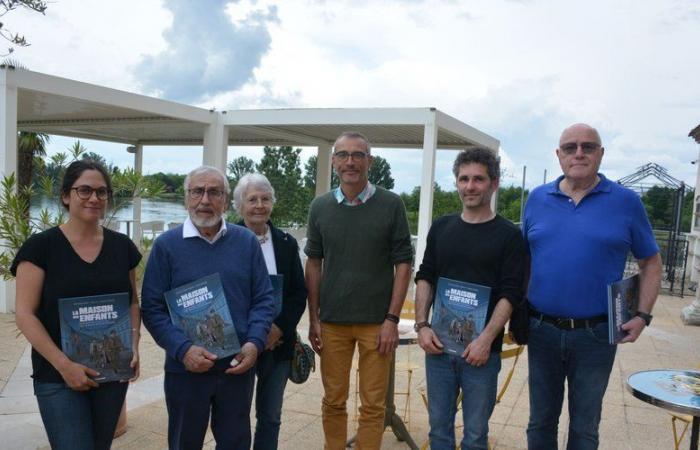essential
Organized by the L’Ancrier bookstore, the Dating-Dedication with Pierre-Roland Saint-Dizier, screenwriter of the BD, took place at the Moulin de Moissac.
It was a glorious interlude of Moissagaise history during a black era of the 20th century. With the support of the mayor of the time, Roger Dorthil, still marked by the surge of solidarity that the city experienced after the terrible murderous flood of March 1930, Moissac was, in turn, tender his hand by welcoming young Israelite scouts in particular during the dark hours of the collaboration of the French State with the third Reich, then under the occupation of the latter’s administration from 1942.
The children, who were then grouped with their educators (around Shatta and Bouli Simon) in the now famous Jewish children’s house, on the right bank of the Tarn, at the foot of the Napoleon bridge, will be dispersed in the surrounding farms.
The Moissagaise population has been admirable, now a silence of brassy until a very recent era, and we owe to the Moissac association, a city of the just forgotten, created by the own son of Shatta and Bouli, Jean-Claude Simon, the so deserved highlighting of this heroic episode. If many works and several historians, at the forefront of which François Boulet, himself born in Moissac, have looked into the period, it is the turn, today, of the world of comics to evoke it. Pierre-Roland Saint-Dizier and his friend Andrea Mutti already met iron with the history of the Uval city a few years ago, on one of the volumes of “Stellae campus, on the paths of Compostela”, an epic suite at the heart of the Christian Middle Ages. Respectively screenwriter and designer, they have just been released, associated with the illustrator Angelo Busschini, with full wind editions, a work totally dedicated to the rescue of the Jewish children in Moissac.
A fair tone, without pathos
“The Maison des enfants” (the book is prefaced by François Boulet) favors the clear line and succeeds in the tour de force to evoke this period with accuracy without falling into the pathos.
On Sunday, the floating bookstore L’Ancrier, which wets permanent in the port of Moissac and which has established itself as an essential cultural place, received Pierre-Roland Saint-Dizier to dedicate the work. The meeting finally held in the municipal hall of the nearby Moissac mill. “It was more prudent in the face of the meteorological threat, and then this place is also an integral part of the history of the Jewish children of Moissac,” delivered Claire Alizart, bookseller at the Ancrier and organizer of the event, in partnership with the city’s heritage service which organized in parallel, in the afternoon, a wander told by Loïc Lepreux around the key places.
We can say that success was there with a long procession of readers who, throughout the afternoon, subjected their respective copies to the pen of Pierre-Roland Saint-Dizier, who very kindly submitted to the exercise.
“It makes you want to deepen”
We could see on this occasion Jean-Claude Simon and his wife Denise, who came for the occasion, as well as Jérôme Pougnand, elected, representing the municipality. “The evocation of this story from the Vél’Hiv roundup is well led in this comic strip, it makes you want to deepen,” delivered a reader keen on history with its copy in your hands, which also appreciates the quality of the drawing and the model. The book is, of course, available at the L’Ancrier bookstore, on the Canal Basin, in Moissac.
In the footsteps of Jewish children with the heritage service
On Sunday, the L’Ancrier bookstore received, for an afternoon dedication (which, finally, took place in the municipal hall of the Moulin de Moissac due to an uncertain weather), Pierre-Roland Saint-Dizier, screenwriter of the comic strip dedicated to the Jewish children’s house which has just been released in full wind editions. This humanist episode of Moissagaise history in a period, the occupation, which was much less so, the heritage service of the city of Moissac, in the person of its Loïc Lepreux official, also decided to approach it as a counterpoint to the dedication by a guided tour between two showers.
DDM – C.L.
From the town hall square, Loïc Lepreux recalled this singular link that can be established between the terrible flood of 1930 that the city underwent and the reception of refugees during the Second World War. “We have a debt to pay, we pay it”, such were the words of the mayor Roger Dorthil in 1939, who had not forgotten that, nine years earlier, the national and international communities had come to the rescue of his city.
A Land of Home
Moissac therefore became a reception land for those who fled war. The Spaniards already in 1936, then the inhabitants of the north of the country, the Belgians … It is estimated to be no less than 40,000 people who transited through the Uval city. A Moissagaise house on the port quay was thus retained by the administration to accommodate young Israelite scouts, which was maintained by the Vichy regime.
This house, managed by Shatta and Bouli Simon, will succeed in the tour de force to maintain the soul of Judeity while allowing several hundred children to integrate into the Moissagais through school and vocational training. After the Vel’d’Hiv roundup in 1942, the children had to be dispersed in the countryside, and the Moissagais will prove to be exemplary in their silence. The visit symbolically ended at the Moulin de Moissac, the place of the dedication.








